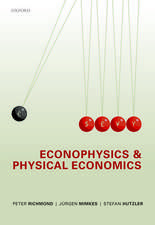Sensitivity & Uncertainty Analysis, Volume 1: Theory
Autor Dan G. Cacucien Limba Engleză Hardback – 28 mai 2003
Preț: 1112.83 lei
Preț vechi: 1357.11 lei
-18% Nou
Puncte Express: 1669
Preț estimativ în valută:
212.99€ • 219.50$ • 179.82£
212.99€ • 219.50$ • 179.82£
Carte tipărită la comandă
Livrare economică 03-17 martie
Preluare comenzi: 021 569.72.76
Specificații
ISBN-13: 9781584881155
ISBN-10: 1584881151
Pagini: 304
Ilustrații: 5 Illustrations, black and white
Dimensiuni: 156 x 234 x 22 mm
Greutate: 0.56 kg
Ediția:UK edition
Editura: CRC Press
Colecția Chapman and Hall/CRC
ISBN-10: 1584881151
Pagini: 304
Ilustrații: 5 Illustrations, black and white
Dimensiuni: 156 x 234 x 22 mm
Greutate: 0.56 kg
Ediția:UK edition
Editura: CRC Press
Colecția Chapman and Hall/CRC
Public țintă
ProfessionalCuprins
As computer-assisted modeling and analysis of physical processes have continued to grow and diversify, sensitivity and uncertainty analyses have become indispensable investigative scientific tools in their own right. While most techniques used for these analyses are well documented, there has yet to appear a systematic treatment of the method based on adjoint operators, which is applicable to a much wider variety of problems than methods traditionally used in control theory. This book fills that gap, focusing on the mathematical underpinnings of the Adjoint Sensitivity Analysis Procedure (ASAP) and the use of deterministically obtained sensitivities for subsequent uncertainty analysis.
Descriere
There has yet to appear a systematic treatment of the method based on adjoint operators, which is applicable to a much wider variety of problems. This book fills that gap, focusing on the mathematical underpinnings of the Adjoint Sensitivity Analysis Procedure (ASAP).











